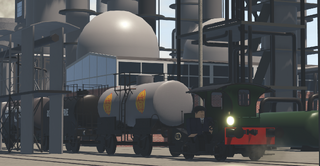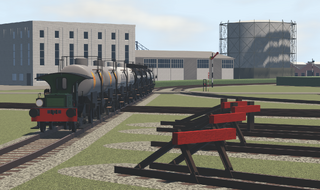 | |
| NS 100 | |
|---|---|
| by Supersnel11 | |
| Price | ƒ100.000 |
| Level | 30 |
| Statistics | |
| Type | Shunter |
| Top Speed | 30 km/h |
| Weight | 12 tons |
| Capacity | 240 tons |
| Length | 5,8 meters |
The NS 100 was a class of 52 Dutch AA (two axles, each powered) petrol locomotors. They were mainly used for shunting.
Variants
The NS 100 is only available in Nederlandsche Spoorwegen green.
Historical details
The prototypes
After the fails of NS 1, designs were made for an upgraded version which would be NS 2. The most notable improvements were controls accessible from either side of the machine and automatic couplings. NS 2 was never build, but these innovations, among with a handful of other design principles, were given to NS 101. NS 101 was put into service on November seventh, 1927. would be the second locomotive of NS. It had a 30 hp petrol motor, but was too weak for the work on various stations, so NS 102 was designed. This locomotor sufficed for a while.
NS 103-152
The favourable results with NS 102 was the cause for an order for six locomotors (103-108) of a third, and final, design that was placed on October 11th, 1929. Nearly a year later, during early June of 1930, an order for another 11 (109-119) were placed at Schwartzkopff. They were put into service that same year, bringing the total amount of NS 100s to 19. Werkspoor delivered an additional 11 in 1931 and the last 22 in 1932.
Until about 1935, the vast majority worked through-out the Netherlands with only a handful being stationed in Holland and the province Utrecht. The 128-132 were reserved for usage at NS workshops. The rest of the class was used for shunting on smaller stations, which reduced the time goods trains needed to take on or drop off wagon. The time saved was so much that plans were made for stopping goods trains with a lot of small, intermediate stations would get NS 100s stationed at all small stations along the line. However, this would cost too much.
Instead, the NS 100s would pull short trains from their post to nearby stations. Eventually they would be used on convoy trains. These were slow, short goods trains that would bring or retrieve wagons stored at the 100s station to nearby stations where they were actually needed. The locomotors were too weak for these jobs as they would struggle with more than six loaded wagons. Eventually they were allowed to pull, at most, two wagons. Partially due to their capabilities, partially because any more would cause troubles with the security system.
The arrival of the NS 200 would give the 100s much less to do. Until 1940 they mostly did seasonal shunting on small stations that had periodically larger influxes of goods.
Withdrawals
NS 107 was the first to be withdrawn; it was sold in 1939. The 149 was destroyed in a collision in 1940.The NS 130 & 149 were put out of service in 1941. In the same year the NS 130 was ordered to be sent to Poland by the occupying forces. It ended up in Czechoslovakia and did not return until 1949, but as written off as 'sold' in 1941. NS 110 & 134 were badly damaged in 1940. They were meant to be returned to service in 1941/42, but were withdrawn in 1942. 23 of these locomotors were taken to Germany during the war; 19 returned.
A majority of the series, including the four missing ones, were withdrawn in 1947 and 1948. The last to go were the 109, 119 and 148 in 1950.
Preservation

After their withdrawal various NS 100s were sold to other companies. Eleven were bought by the company Spoorijzer, which traded and rented narrow gauge rolling stock. Spoorijzer bought the NS 112/14/22/25/28/29/38/41/44/46 and 151 and gave each a new motor and their own number. Because of a fire in their archives, it is no longer possible to determine which number they gave to each engine, but two of the NS 100s they bought survive to this day, with seven in total surviving.
Currently, NS 103 & 137 on static display at the Dutch railway museum, NS 116 is on static display at the heritage railway Veluwsche Stoomtrein Maatschappij, NS 122 is present at the heritage railway Stoomtrein Goes-Borsele, NS 125 & Spoorijzer 145 are at the heritage railway Museum Buurtspoorweg with only the 145 being operational. Spoorijzer 5 is owned by Stichting SEIN in Enschede.
Technical details
The frame of the NS 100 are made out of two 40 mm thick plates. The axles had rolling bearings. The buffers were standard locomotive buffers with lighter springs and an automatic coupling. All four corners had a decoupling lever. The whistle was connected to the exhaust pipe, so the engine vibrations were heard during whistles. This reminded the drivers of the bleating of goats, so these were nicknamed 'sikken' (goatees) and later 'oersikken' (ancient goatees) when their big brothers, the NS 200, entered service.
NS 102-153 had four gears. Two for shunting, with a maximum speed of 12 km/h, and two for speed to a maximum of 30 km/h.
NS 102-128 had a deadman's mechanism that was a button that had to be pressed down to keep the ignition going. If the button was released, it would stop the motor immediately. This only worked in the two highest gears. NS 133-152 were fitted with a deadman's mechanism that would cut the fuel to the motor when the throttle lever was let go. The 129-1932 did not have a Deadman's mechanism at all, given their job as workplace engines. Instead, they had a foot brake that could be locked in brake mode.
In 1942 the NS 116/17/24 & 129 were modified to drive on coal gas instead of petrol so they could continue to shunt in the wagon workshops at Amersfoort and Blerick. This installation was removed from the 116 ans 124 in 1943.
Trivia
- The NS 100 is comedically poorly performing high level shunter, but not as bad as the NS 1.
- The NS 100 was added as a thank you for 100k visits, which is reflected in the price of 100k too.
- The NS 100 had such little pulling and braking power that they had had trouble with 6 loaded wagons. However, for balancing reasons, in Streamlined they can pull 8.
- NS 100 has been available since version 0.2.7.
Gallery
-
NS 127 picks up loaded wagons at the KITE refinery in Dokmuiden.
-
An unidentified NS 100 with a couple chemical wagons crosses the mainline.


